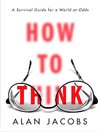
Saved by Francesca Galli and
How to Think: A Survival Guide for a World at Odds

Saved by Francesca Galli and
in many arguments there truly is something to be lost, and most often what’s under threat is social affiliation. Losing an argument can be a personal embarrassment, but it can also be an indication that you’ve sided with the wrong people, which means that you need to find a new ingroup or else learn to live with what the Marxists call “false
... See moreOptimistic attempts to promote what is Clearly Right will be presented as a pursuit of the common good, but Scruton believes that the attitude underlying them is always “I”-based: it’s for the good of me and people whose views are generally indistinguishable from mine. To this “I” attitude Scruton contrasts the “we” attitude—not the most felicitous
... See moreThe Myths We Live By. Introducing her theme, Midgley writes, Myths are not lies. Nor are they detached stories. They are imaginative patterns, networks of powerful symbols that suggest particular ways of interpreting the world. They shape its meaning. For instance, machine imagery, which began to pervade our thought in the seventeenth century, is
... See morehe explores this psychology The True Believer (1951). It might seem from that title that Hoffer is talking about something quite similar, if not identical, to the kind of delusion Marian Keech’s followers suffered from. But it is not so dramatic; it is perhaps even less dramatic than the sort of thing that prompts a South Sea Bubble, most
... See moreT. S. Eliot wrote almost a century ago about a phenomenon that he believed to be the product of the nineteenth century: “When there is so much to be known, when there are so many fields of knowledge in which the same words are used with different meanings, when everyone knows a little about a great many things, it becomes increasingly difficult for
... See moreThe “true believer” of Hoffer’s title is someone who belongs not to the few but to the many, someone who strives to bring the entire group (the church, the nation, the world even) within the grip of one narrative, the force of one body of belief, the authority of one charismatic Leader. This kind of fanaticism has no interest in Inner Rings; its
... See moreLewis thinks that the modern Western world tends to give us a choice between solitude—not always easy to choose—and “inclusion in a collective,” a collective for Lewis being an environment in which we all have more or less the same status and identity: as, for instance, part of the audience at a concert, or the crowd at a football game. What tends
... See more“I believe that in all men’s lives at certain periods, and in many men’s lives at all periods between infancy and extreme old age, one of the most dominant elements is the desire to be inside the local Ring and the terror of being left outside.” And it is important for young people to know of the force of this desire because “of all passions the
... See morethere are healthier kinds of group affiliation, and one of the primary ways we can tell the difference between an unhealthy Inner Ring and a healthy community is by their attitudes toward thinking. The Inner Ring discourages, mocks, and ruthlessly excludes those who ask uncomfortable questions.